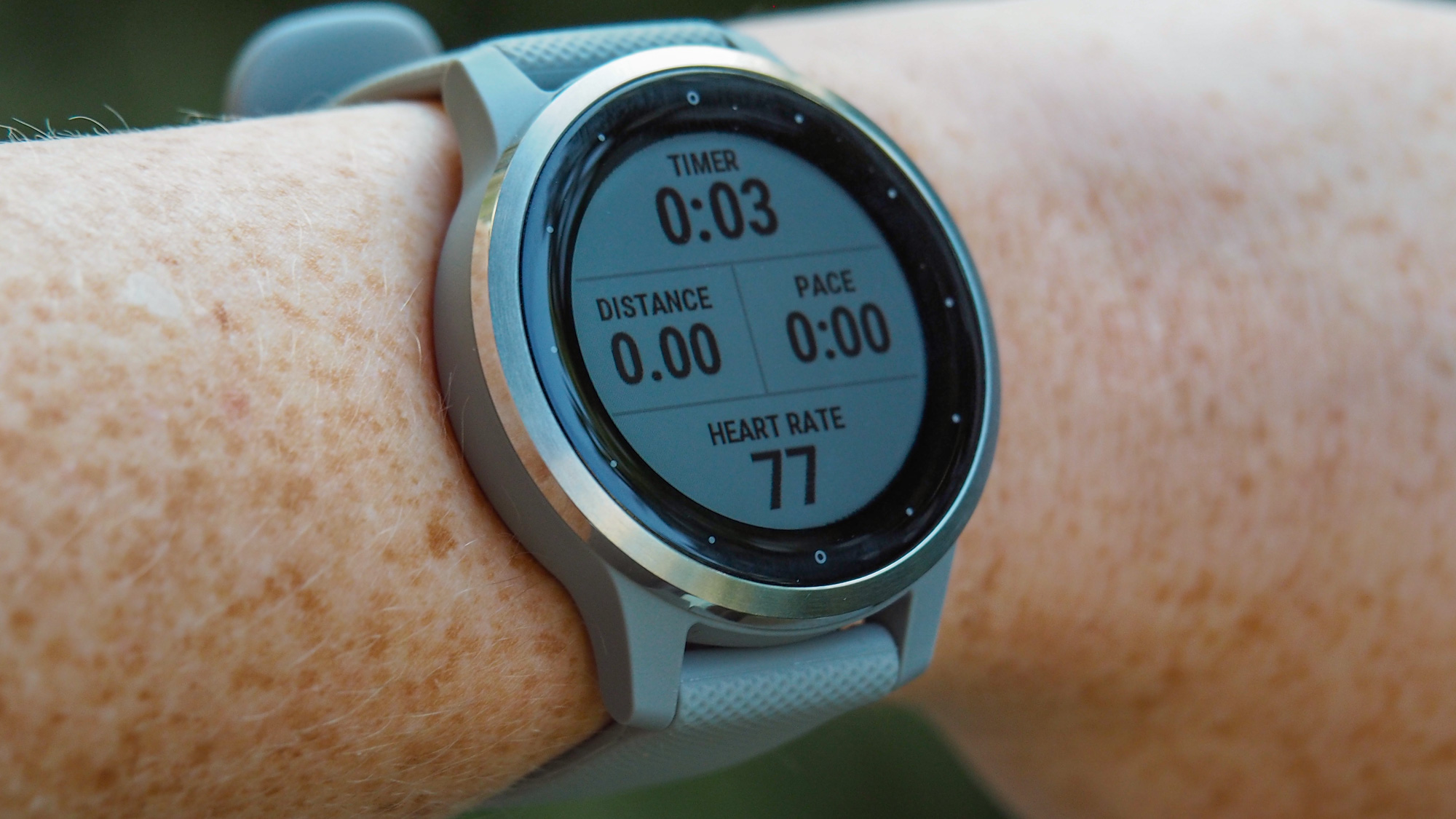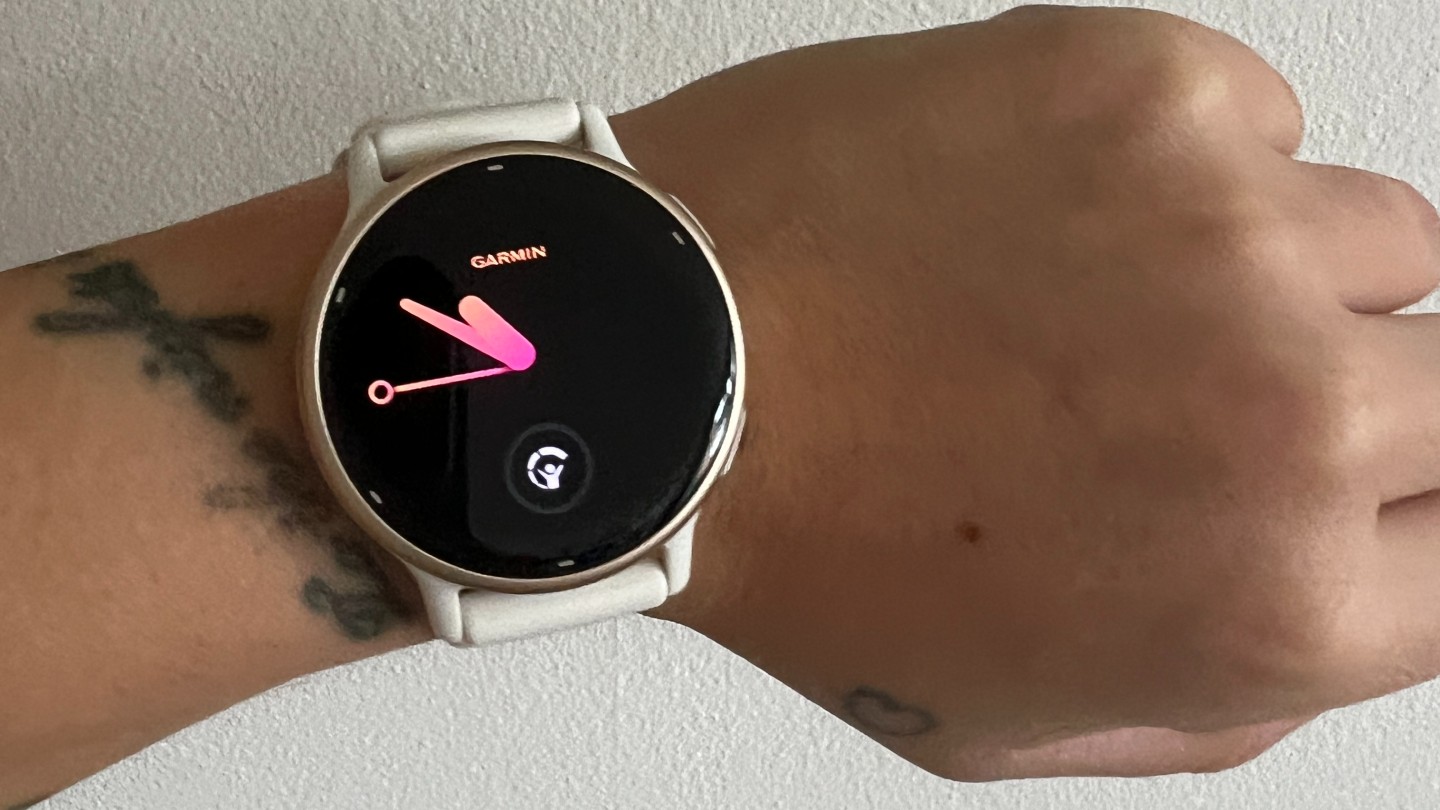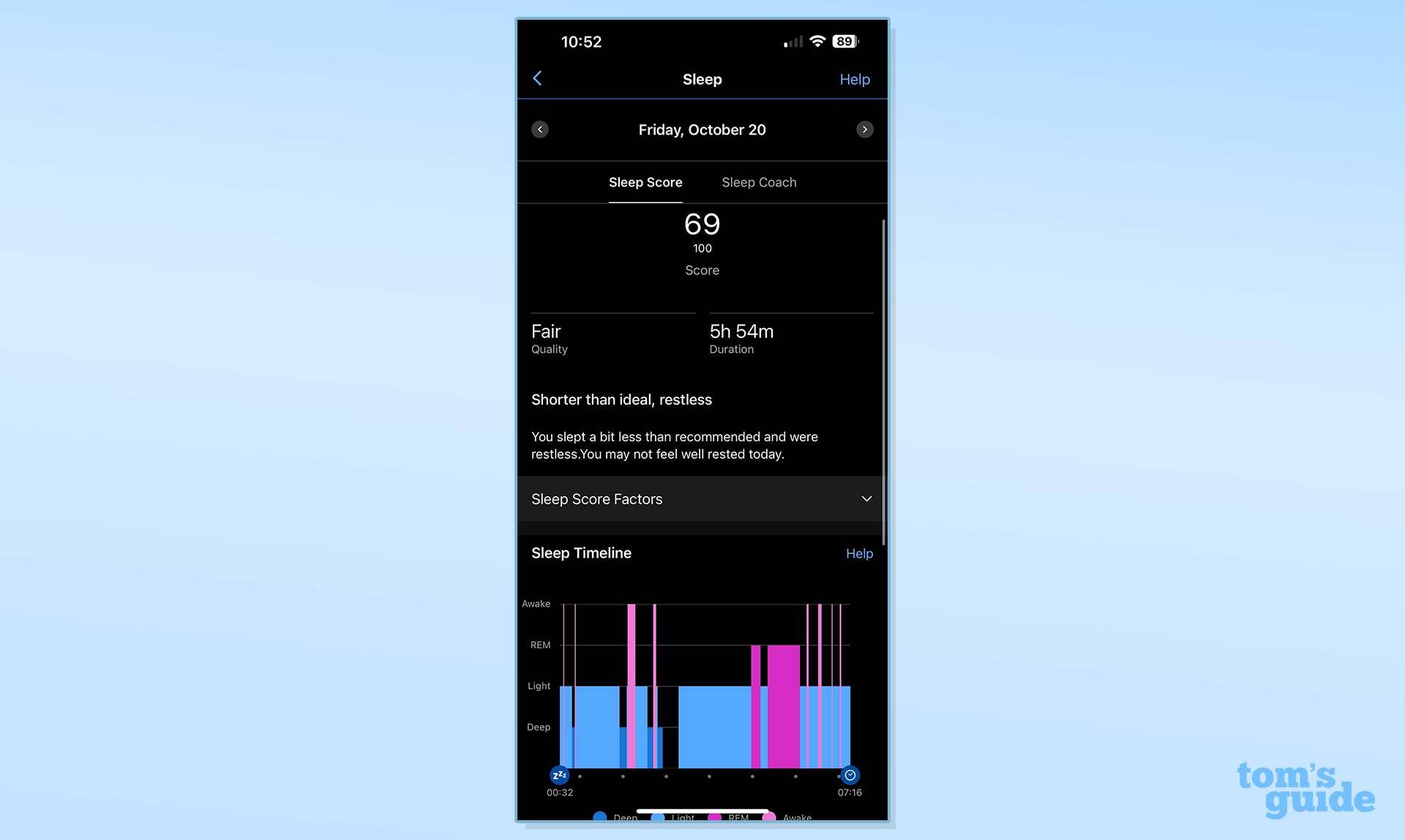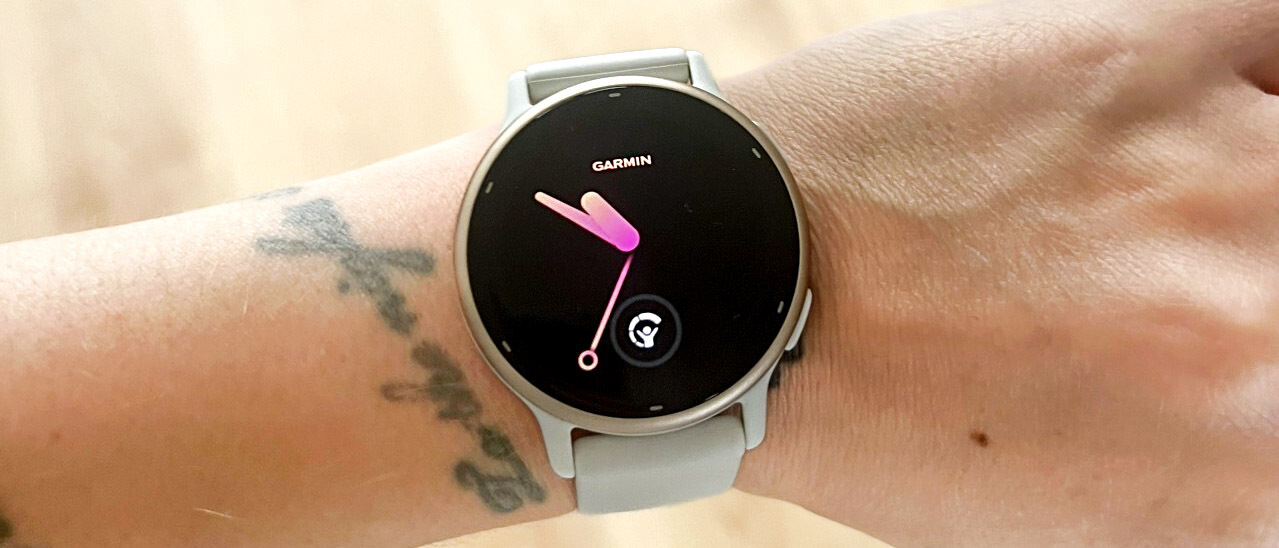Tom's Guide Verdict
The Garmin Vivoactive 5 offers even more features than we could keep track of at a more affordable price than the Garmin Venu 3 and Vivoactive 4, with more advanced health stats, 30-plus sports apps, workouts and upgraded sleep and stress coaching.
Pros
- +
Advanced health stats like sleep and stress coaching
- +
30-plus sports apps
- +
Upgraded AMOLED display
Cons
- -
Inconsistent sleep data
- -
Buttons are stiff
- -
No barometric altimeter
Why you can trust Tom's Guide
The Garmin Vivoactive 5 is certainly a more comprehensive on-wrist health and fitness coach than its predecessor, the Vivoactive 4, although it still lags behind more sports-focused series like the Forerunner range or the Garmin Venu.
The latest surprise from Garmin features an updated AMOLED display like the Garmin Venu 3, replacing the older MIP display and giving a facelift to the Vivoactive 4’s existing health and fitness features.
At first glance, the 45mm case of the Vivoactive 4 has been reduced to 42mm, but despite the smaller display size, users won’t be disappointed with its bright clarity and sleek look. And there are more health and fitness features than we know what to do with, including 24/7 sleep coaching, stress tracking and new sporting modes that recognize eBike activity.
We rate the Garmin Vivoactive 5 as one of the best fitness trackers and best Garmin watches with some notable new features to consider if you’re thinking about upgrading.
Garmin Vivoactive 5 review: Design and display
The first major design difference between the Garmin Vivoactive 5 and its predecessors centers around size. The Vivoactive 4 offers two sizes: 40mm (the Garmin Vivoactive 4S) and 45mm, and the Vivoactive 3 has just one size: 43mm. Garmin’s newest smartwatch also has one size, a 42mm case and a 1.2-inch AMOLED screen that isn’t far off the look of the Apple Watch series 9. It also closely aligns with the Garmin Venu 3.
I don’t think the smaller screen reduces the quality overall, and for small wrists, it’s a good fit.
The watch now houses a silicone strap and aluminum bezel rather than the stainless steel design of its predecessor, along with a polymer case. It’s about as lightweight as it gets, so much so that I often forgot I was wearing the Vivoactive 5.
Get instant access to breaking news, the hottest reviews, great deals and helpful tips.

Garmin has kept the second side button, which still acts as a back button when you’re in an app. Press and hold the button, and you’ll get quick access to the watch face, clock and settings, which is handy, but I found it slightly fiddly to press while moving. As with most touchscreen smartwatches, using them in the rain can be a faff.
The top side button takes you directly to apps and activities, allowing you to scroll through various sports and exercises using the super responsive touchscreen, which you can also find in the Garmin Connect app.
The Vivoactive 5 is about as lightweight as it gets, so much so that I often forgot I was wearing it.
One of our Tom’s Guide testers recommends the Garmin Venu if you’re looking for a mid-sized option between the Vivoactive 4 and 4S, which houses a slightly bigger case than the 5 (43mm) and also has an AMOLED display. It's considered the “Goldilocks” between the two.
Garmin’s latest fitness smartwatch costs $299/£259.99 compared to the Garmin Vivoactive 4, which cost $349 upon release, and the Garmin Venu 3, costing $449.99/£459.99.
How we tested
I’ve tested the Vivoactive 5 smartwatch during runs, various strength-based workouts and recovery sessions like walks and yoga classes. I also looked at the features available and wore it 24/7 for tracking stats like sleep, stress and morning reports alongside the Oura Ring Gen3 and Apple Watch series 7.
Garmin Vivoactive 5 review: Fitness features
Get ready for fitness overload. The Vivoactive 5 now has more than 30 preloaded GPS and indoor sports apps compared to 20 on the Vivoactive 4. That includes exercises like pool swimming, cycling, running, strength training and activities for wheelchair users, which is an excellent addition to one of the best running watches.
Having always been associated with runners and outdoor enthusiasts, the Vivoactive 5 builds on its predecessor with even more customized training plans and pre-made workouts accessible for download in the Garmin Connect app, along with access to new guided meditations, HIIT, yoga, Pilates, pickleball, padel, meditation and more.
You can still access Garmin Coach, VO2 max, Sleep Coach, stress and body battery tracking, with each feature dialed up to work better.
There are some favorite features worth mentioning. For the keen runners, Garmin Coach provides access to 5K,10K and half-marathon training plans, and wheelchair mode tracks daily pushes, provides weight shift alerts and offers workouts and sports apps tailored to wheelchair users.


You can also estimate your fitness age with the Vivoactive 5 using more metrics than older models, including VO2, resting heart rate, body fat percentage and BMI; Garmin will suggest actionable steps to improve your score.
Users have more workout options than ever before and can create step-by-step workout plans from a library of 1,600 exercises and send them to the watch, build interval workouts for running and cycling and measure perceived exertion (how fatigued you feel) after workouts. That’s all alongside the standard activity tracking like daily steps, recovery and calories burned.
If you’re interested in learning more about recovery, I didn’t find the metrics very advanced, and users may find more in-depth insights on the Forerunner series.
I’m a huge fan of the muscle-mapping feature, which is available for strength workouts and tells me which muscles I’m using, when and the benefits. As with the Vivoactive 4, the Vivoactive 5 allows you to access guided exercise displays in-app during yoga and Pilates, but the helpful on-screen animations found on the 4 and Venu 3 are no longer available — a strange choice by Garmin.
Otherwise, the Vivoactive 5 is just as advanced at fitness tracking as you’d expect from Garmin watches, locating GPS signals quickly, mapping routes pretty accurately and combining brilliant battery life with plenty of sporting options.
So what’s missing? Worth noting is that the Vivoactive 5 has the Elevate V4 heart rate sensor rather than the V5 found on Garmin Venu 3, and the barometric altimeter and floors climbed features have been removed.
Garmin Vivoactive 5 review: Health and sleep-tracking features
Not only does the Vivoactive 5 excel in fitness, but it’s also taking on the likes of Apple and Oura with advanced health insights such as respiration tracking, blood oxygen levels, sleep and stress monitoring.
However, you’ll need to wear the watch to bed each night to receive accurate sleep and readiness scores. That requires you to keep the watch fitted snugly so that the sensors can pick up activity accurately.
I’ve been using the Oura Ring Gen3 to manage my stress and sleep cycles for several years, so I was keen to compare the data with the Vivoactive 5. Sadly, they didn’t align. Oura claims to offer the gold standard of clinical-grade health tracking, but we haven’t been able to independently verify that claim. Instead, I can only go off of my experiences with each model.
The Vivoactive 5 consistently noted my total sleep to be less than Oura's, reporting later sleep times and lower scores overall. One night, Garmin recorded 5 hours 54 minutes and a score of 69 compared to Oura, which recorded a 77 score and 7 hours 30 minutes of sleep with 91% efficiency.
Oura reported that I feel asleep at 11:05 p.m. compared to Garmin, which recorded 00:32. Both recorded the same wake-up time. Interestingly, both picked up REM and deep sleep differently, yet the devices reported 29 minutes of deep sleep.

Garmin uses sleep data to determine readiness scores based on heart rate, heart rate variability (HRV), respiration rate and body movement data. Oura also uses these along with biosignals like skin temperature. In my experience, I’ve found Oura to be the most accurate, reliable and in-depth since testing based on Oura’s accuracy studies.
I love that the Garmin body battery tells you how rested you are, and the stress feature reports how much time you spend resting or in low, medium, or high states of stress, along with tips to improve. The sleep coach feature shows nap data and recommendations to improve your sleep cycle based on lifestyle data and your recorded sleep metrics.
So far, I haven't found the insights on the Vivoactive 5 to be as in-depth or reliable as the Oura Ring, but I imagine the upgraded V5 sensors (used with the likes of Garmin Venu 3) would enhance accuracy across the board.
Garmin Vivoactive 5 review: Battery life
Garmin battery life outshines the Apple Watch any day of the week, and the Vivoactive 5 is no different. Garmin says the battery life should last up to 11 days in smartwatch mode and five days with display always-on. If you switch to the battery saver smartwatch mode, you should get up to 21 days, and with GPS-only on, up to 21 hours. I found this pretty accurate, considering GPS famously drains battery life.
In comparison, our Garmin Vivoactive 4 tester reported 4 days of battery life with music playback and GPS activated and 7 days in smartwatch mode. There’s no comparison with Apple, as I have to charge my Apple Watch 7 every day. We recommend switching off the pulse oximeter sensor to save battery if you don’t use it, as this could help preserve battery life.

Garmin Vivoactive 5 review: Other features
Like the Vivoactive 4, you can download Spotify playlists on to the Vivocative 5 with a paid Spotify Premium subscription. It’s still a bit of a process and not that intuitive, but available nonetheless, along with Amazon Music, Deezer, and the Garmin Pay feature. You’ll still need to download Garmin’s Connect IQ score to access available third-party apps, widgets and clock faces. Android owners can also view photos and reply to texts from the watch screen. No such luck for iPhone users or those with an older Vivoactive model.
You can swipe quickly between widgets, notifications and morning reports, but it takes some time to get used to on the Vivoactive 5. I still get lost and overwhelmed with the number of features available, and it doesn’t feel particularly intuitive to navigate, but I guess that just takes time. That said, the new morning reports are helpful, and with a quick swipe up, I can access sleep data, steps, and more at a glance.
Other noteworthy features include a 5ATM water-resistance rating for swimmers and 4GB of storage.
Garmin Vivoactive 5 review: Verdict
Despite the saturated market, it makes sense to upgrade your Garmin this time. The Vivoactive 5 costs less than the Vivoactive 4 and Venu 3, and there's more to love than the model before it, including advanced sports features and an upgraded AMOLED screen design. Many of the features from the Vivoactive 4 are still available, yet you get an upgraded HR sensor (V4, not the latest), GPS, HRV, heart rate tracking and more fitness options.
The Vivoactive 5 smartwatch serves even more proof that Garmin takes sports and fitness tracking capabilities very seriously. It’s less intuitive than the Apple Watch, and the Garmin Connect IQ store has to catch up to compete with Apple or Google, but if fitness tracking is what you’re looking for, Garmin sports watches are solid investments and great value.
To find the right Garmin watch for you, be sure to scroll through our buying guides to see how each model compares, and we also recommend checking out the early Black Friday deals to see if your favorite watch is on sale. And if you’re looking for a sportier model with mode in-depth training analysis at an affordable price, check out the Garmin Forerunner 265.
More from Tom's Guide
- Garmin Forerunner 265 vs Garmin Forerunner 965
- Garmin Forerunner 965 vs Garmin Epix Pro: which watch should you buy?
- Garmin's new Venu 3 has the smartwatch feature I've been waiting for

Sam Hopes is a level 3 qualified trainer, a level 2 Reiki practitioner and fitness editor at Tom's Guide. She is also currently undertaking her Yoga For Athletes training course.
Sam has written for various fitness brands and websites over the years and has experience across brands at Future, such as Live Science, Fit&Well, Coach, and T3.
Having coached at fitness studios like F45 and Virgin Active and personal trained, Sam now primarily teaches outdoor bootcamps, bodyweight, calisthenics and kettlebells.
She also coaches mobility and flexibility classes several times a week and believes that true strength comes from a holistic approach to training your body.
Sam has completed two mixed doubles Hyrox competitions in London and the Netherlands and finished her first doubles attempt in 1:11.

